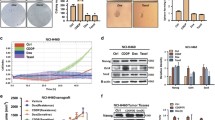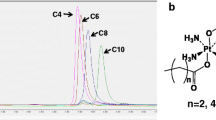Abstract
Background
Chemoresistance remains a major challenge for effective chemotherapy of non-small-cell lung carcinoma (NSCLC). CD44 expression is related to the susceptibility of various cancer cell types to anticancer drugs. Here, we systematically investigated the CD44-dependent chemoresistance of NSCLC cells and developed a liposomal siRNA delivery system to overcome this chemoresistance by the self-targeted downregulation of CD44.
Methods
We confirmed the relationship between the expression of CD44 and the chemosensitivity of NSCLC cells using flow cytometry and MTT assay. We then generated and characterized cisplatin-resistant cell lines and compared the expression of CD44 in resistant cells to that in parental cells using western blotting. To evaluate whether the chemosensitivity of resistant cells depends on CD44 expression, we performed CD44 knockdown using CD44 siRNA and detected the chemosensitivity of these cells. Additionally, we prepared hyaluronic acid (HA)-coated liposomes as a targeted delivery system to selectively deliver CD44-specific siRNA to chemoresistant NSCLC cells and observed whether the chemosensitivity of these cells was improved.
Results
We found that CD44 expression is inversely proportional to the degree of cellular response to cisplatin chemotherapy and that CD44 is overexpressed in chemoresistant NSCLC cells. By performing CD44 knockdown using siRNA, we reconfirmed that the chemosensitivity of resistant cells depends on CD44 expression. We also observed that HA-liposome-mediated siRNA delivery prior to cisplatin chemotherapy significantly reduced CD44 expression and enhanced cisplatin sensitivity in chemoresistant NSCLC cells.
Conclusions
These results suggest that self-targeted downregulation of chemoresistance-associated cell surface proteins during chemotherapy is an effective therapeutic strategy for overcoming the chemoresistance of NSCLC cells.





Similar content being viewed by others
Data Availability
The datasets used and/or analyzed during the current study are available from the corresponding author on reasonable request.
Abbreviations
- NSCLC:
-
Non-small cell lung cancer
- HA:
-
Hyaluronic acid
- CSC:
-
Cancer stem cell
- MTT:
-
3-[4,5-Dimethylthiazole-2-yl]-2,5-diphenyltetrazolium bromide
- SF:
-
Surviving fraction
- DiI:
-
1,1′-Dioctadecyl-3,3,3′,3′-tetramethylindocarbocyanine perchlorate
- BAX:
-
BCL2-associated X apoptosis regulator
- GAPDH:
-
Glyceraldehyde-3-phosphate dehydrogenase
- DAPI:
-
2-(4-Amidinophenyl)-1H-indole-6-carboxamidine
- MDR1:
-
Multidrug-resistant protein
- MRP2:
-
Multidrug resistance-associated protein 2
References
Rich JN, Bao S (2007) Chemotherapy and cancer stem cells. Cell Stem Cell 1:353–355
Szakacs G, Paterson JK, Ludwig JA, Booth-Genthe C, Gottesman MM (2006) Targeting multidrug resistance in cancer. Nat Rev Drug Discov 5:219–234
Longley D, Johnston P (2005) Molecular mechanisms of drug resistance. J Pathol 205:275–292
Kachalaki S, Ebrahimi M, Khosroshahi LM, Mohammadinejad S, Baradaran B (2016) Cancer chemoresistance; biochemical and molecular aspects: a brief overview. Eur J Pharm Sci 89:20–30
Abdullah LN, Chow EK-H (2013) Mechanisms of chemoresistance in cancer stem cells. Clin Transl Med 2:3
Alamgeer M, Peacock CD, Matsui W, Ganju V, Watkins DN (2013) Cancer stem cells in lung cancer: evidence and controversies. Respirology 18:757–764
Dragu DL, Necula LG, Bleotu C, Diaconu CC, Chivu-Economescu M (2015) Therapies targeting cancer stem cells: Current trends and future challenges. World J Stem Cells 7:1185
Eramo A, Haas T, De Maria R (2010) Lung cancer stem cells: tools and targets to fight lung cancer. Oncogene 29:4625–4635
Pham PV, Phan NL, Nguyen NT et al (2011) Differentiation of breast cancer stem cells by knockdown of CD44: promising differentiation therapy. J Transl Med 9:209
Zhao S, Chen C, Chang K et al (2016) CD44 expression level and isoform contributes to pancreatic cancer cell plasticity, invasiveness, and response to therapy. Clin Cancer Res 22:5592–5604
Zhang S, Balch C, Chan MW et al (2008) Identification and characterization of ovarian cancer-initiating cells from primary human tumors. Cancer Res 68:4311–4320
Hiscox S, Baruha B, Smith C et al (2012) Overexpression of CD44 accompanies acquired tamoxifen resistance in MCF7 cells and augments their sensitivity to the stromal factors, heregulin and hyaluronan. BMC Cancer 12:458
Dick D (1997) Human acute myeloid leukemia is organized as a hierarchy that originates from a primitive hematopoietic cell. Nat Med 3:1
Hong SP, Wen J, Bang S, Park S, Song SY (2009) CD44-positive cells are responsible for gemcitabine resistance in pancreatic cancer cells. Int J Cancer 125:2323–2331
Boulbes DR, Chauhan GB, Jin Q, Bartholomeusz C, Esteva FJ (2015) CD44 expression contributes to trastuzumab resistance in HER2-positive breast cancer cells. Breast Cancer Res Treat 151:501–513
Bjorklund CC, Baladandayuthapani V, Lin HY et al (2014) Evidence of a role for CD44 and cell adhesion in mediating resistance to lenalidomide in multiple myeloma: therapeutic implications. Leukemia 28:373–383
Roudi R, Madjd Z, Ebrahimi M, Samani F, Samadikuchaksaraei A (2014) CD44 and CD24 cannot act as cancer stem cell markers in human lung adenocarcinoma cell line A549. Cell Mol Biol Lett 19:23–36
Sung WJ, Park K-S, Kwak SG, Hyun D-S, Jang JS, Park K-K (2015) Epithelial-mesenchymal transition in patients of pulmonary adenocarcinoma: correlation with cancer stem cell markers and prognosis. Int J Clin Exp Pathol 8:8997
d’Amato TA, Landreneau RJ, McKenna RJ, Santos RS, Parker RJ (2006) Prevalence of in vitro extreme chemotherapy resistance in resected nonsmall-cell lung cancer. Ann Thorac Surg 81:440–447
Katayama R, Shaw AT, Khan TM et al (2012) Mechanisms of acquired crizotinib resistance in ALK-rearranged lung cancers. Sci Transl Med 4:120ra117–120ra117
Pao W, Miller VA, Politi KA et al (2005) Acquired resistance of lung adenocarcinomas to gefitinib or erlotinib is associated with a second mutation in the EGFR kinase domain. PLoS Med 2:e73
Luo Y, Prestwich GD (1999) Synthesis and selective cytotoxicity of a hyaluronic acid-antitumor bioconjugate. Bioconj Chem 10:755–763
Toole BP, Ghatak S, Misra S (2008) Hyaluronan oligosaccharides as a potential anticancer therapeutic. Curr Pharm Biotechnol 9:249–252
Toole BP, Slomiany MG (2008) Hyaluronan, CD44 and Emmprin: partners in cancer cell chemoresistance. Drug Resist Updates 11:110–121
Quan YH, Kim B, Park JH, Choi Y, Choi YH, Kim HK (2014) Highly sensitive and selective anticancer effect by conjugated HA-cisplatin in non-small cell lung cancer overexpressed with CD44. Exp Lung Res 40:475–484
Leung EL-H, Fiscus RR, Tung JW et al (2010) Non-small cell lung cancer cells expressing CD44 are enriched for stem cell-like properties. PLoS One 5:e14062
Ohashi R, Takahashi F, Cui R et al (2007) Interaction between CD44 and hyaluronate induces chemoresistance in non-small cell lung cancer cell. Cancer Lett 252:225–234
Shi Y, Liu C, Liu X, Tang DG, Wang J (2014) The microRNA miR-34a inhibits non-small cell lung cancer (NSCLC) growth and the CD44 hi stem-like NSCLC cells. PLoS One 9:e90022
Galluzzi L, Senovilla L, Vitale I et al (2012) Molecular mechanisms of cisplatin resistance. Oncogene 31:1869–1883
Bourguignon LY, Spevak CC, Wong G, Xia W, Gilad E (2009) Hyaluronan-CD44 interaction with protein kinase Cϵ promotes oncogenic signaling by the stem cell marker Nanog and the production of microRNA-21, leading to down-regulation of the tumor suppressor protein PDCD4, anti-apoptosis, and chemotherapy resistance in breast tumor cells. J Biol Chem 284:26533–26546
Funding
This work was supported by a Korea University Grant and the National Research Foundation of Korea (NRF) grant funded by the Ministry of Education, Science, and Technology (NRF-2017R1E1A1A01074847) and Korea Health Technology R&D Project through the Korea Health Industry Development Institute (KHIDI), funded by the Ministry of Health & Welfare (Grant no. HI17C0654).
Author information
Authors and Affiliations
Contributions
Conception and design: YHQ, J-HP, and HKK. Development of methodology: YHQ. Acquisition of data (provided materials, provided facilities, etc.): YHn, JL, and YHC. Analysis and interpretation of data (e.g. statistical analysis, biostatistics, computational analysis): YHQ. Writing, review, and/or revision of the manuscript: YHQ, J-HP, and HKK. Administrative, technical, or material support (i.e. reporting or organizing data, constructing databases): JL, YC, and YHC. Study supervision: J-HP and HKK.
Corresponding authors
Ethics declarations
Conflict of interest
All authors read and approved the final version of the manuscript, and the authors declare no conflicts of interest.
Additional information
Publisher’s Note
Springer Nature remains neutral with regard to jurisdictional claims in published maps and institutional affiliations.
Electronic supplementary material
Below is the link to the electronic supplementary material.
Supplementary Fig. 1. Preparation of HA-liposomes for CD44-targeted siRNA delivery
. (A) The hydrodynamic sizes of 5- and 700-kDa HA-liposomes were approximately 144.2 and 156.4 nm, respectively. (B) The 700-kDa HA-liposomes showed notably higher targeting towards CD44-overexpressing H1299 and H1793 cells than H522 and H2087 cells which expressed low levels of CD44. (C) The 1:1 ratio of siRNA to protamine is optimized size for encapsulation of HA-liposomes. (D) Scheme of procedure to prepare siRNA-loaded HA-liposomes. (DOCX 178 KB)
Rights and permissions
About this article
Cite this article
Quan, Y.H., Lim, JY., Choi, B.H. et al. Self-targeted knockdown of CD44 improves cisplatin sensitivity of chemoresistant non-small cell lung cancer cells. Cancer Chemother Pharmacol 83, 399–410 (2019). https://doi.org/10.1007/s00280-018-3737-y
Received:
Accepted:
Published:
Issue Date:
DOI: https://doi.org/10.1007/s00280-018-3737-y




